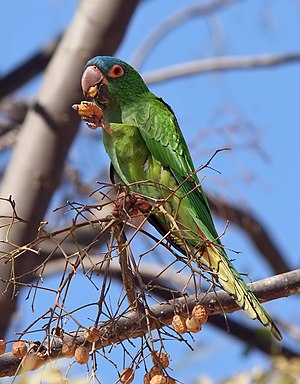Blue-crowned parakeet
| Blue-crowned Parakeet | |
|---|---|

| |
| In San Isidro in Bolivia | |
| Scientific classification | |
| Kingdom: | |
| Phylum: | |
| Class: | |
| Order: | |
| Family: | |
| Genus: | |
| Species: | A. acuticaudata
|
| Binomial name | |
| Aratinga acuticaudata (Vieillot, 1818)
| |
The Blue-crowned Parakeet, Blue-crowned Conure, or Sharp-tailed Conure (Aratinga acuticaudata) is a parakeet native to large parts of South America, from eastern Colombia in the north to northern Argentina in the south. They inhabit savanna-like habitats, woodland and forest margins, but avoid dense humid forest such as the Amazon.
Members of the genus Aratinga are officially called parakeets by the AOU and by birders, though usually called conures in aviculture.
Taxonomy
The Blue-crowned Parakeet has five subspecies:[1]
- Aratinga acuticaudata (Vieillot 1818)
- Aratinga acuticaudata acuticaudata (Vieillot 1818)
- Aratinga acuticaudata haemorrhous Spix 1824
- Aratinga acuticaudata koenigi Arndt 1995
- Aratinga acuticaudata neoxena (Cory 1909)
- Aratinga acuticaudata neumanni Blake and Traylor 1947
Description


The Blue-crowned Parakeet is one of the larger birds in the genus Aratinga measuring approximately 37 cm (14.5 inches) in length and weighing between 140 and 190 grams (4.9 - 6.7 ounces). Blue-crowns have many features common to the Aratinga's, including green plumage, long, tapered tails, horn and black-colored beaks, and featherless eye (periophthalmic) rings.
Blue-crowns are predominantly green, with dull blue coloring on the forehead, crown, cheeks, and ears in the nominate, but less blue in other subspecies. It has a ring of white featherless skin around each eye, though this is bright orange-yellow in wild A. acuticaudata neumanni.[citation needed] The breast feathers may also be tinged with blue, though they are more commonly green to yellow-green. Closed wing coloring matches that of the body while extended wings show blue-brown, becoming chestnut on the outer flight feathers. The tail feathers are green on top, maroon to red-brown on the underside, iridescing to bright orange and scarlet under full-spectrum light. Legs are pink-brown with grey-brown claws. The upper mandible is horn-colored, tapering to a needle-sharp, grey-black tip. In the southern and western nominate and subspecies neumanni, the lower mandible is horn-colored in juveniles, fading to grey-black by the bird's second year. The remaining eastern, central and northern subspecies retain the horn-colored lower mandible throughout adulthood.
Breeding
The Blue-crowned Parakeet's nest is a hole in a tree. The eggs are white and there are usually three to four in a clutch. The female incubates the eggs for 26 days, and the chicks fledge from the nest about 52 days after hatching.[2]
Aviculture
Blue-crowned Parakeets are generally called Blue-crowned Conures in aviculture. They are social birds and are relatively poor talkers,[2] although better than most Aratinga's. They have become quite popular as pets, with a reputation as one of the "easier" parrots to care for. However, they are also intelligent, high-energy birds that require a lot of attention and a cage with ample room and toys. They can also be quite loud at times. Consequently, they are more appropriate companions for serious bird enthusiasts rather than the casual birdkeeper.
Popular culture
The most famous fictional Blue-crowned Conure is the title character in the 1998 movie Paulie. The movie used 14 birds to play the role of the talking parrot and caused a surge in the popularity of Blue-crowned Conures as pets.
A Blue-crowned Conure also played a prominent role in the documentary The Wild Parrots of Telegraph Hill. The movie spends much of its time following Connor, a lonely Blue-crown Conure in a mixed flock of Cherry-headed and Mitred Conures.
References
- ^ "Zoological Nomenclature Resource: Psittaciformes (Version 10.002)". www.zoonomen.net. 2010.01.12.
{{cite web}}: Check date values in:|date=(help) - ^ a b Alderton, David (2003). The ultimate encyclopedia of caged and aviary birds. London, England: Hermes House. p. 193. ISBN 184309164X.
- Template:IUCN2008 Database entry includes a brief justification of why this species is near threatened.
External links
- "Species factsheet: Aratinga acuticaudata". BirdLife International 2008. Retrieved 3 January 2009..
{{cite web}}: Check date values in:|accessdate=(help); Unknown parameter|dateformat=ignored (help)

